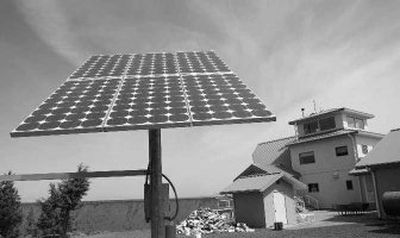Going off the grid

LAKE BILLY CHINOOK, Ore. — Before power lines, homesteaders had no choice. They lit their lanterns, stoked their fires and packed away winter ice against sizzling summers.
Owners of about 250 homes in the Three Rivers community near this central Oregon lake are far from homesteading or camping out. But they are among a growing number of Americans who shun power lines, choosing to live “off the grid,” without commercial power.
Everyone in Three Rivers gets most of their power from dark solar panels on their rooftops or on nearby freestanding structures positioned to more efficiently capture the sun. Some supplement it with energy generated by windmills.
Solar power easily handles their computers, lights, large-screen televisions, microwave ovens, refrigerator-freezers and more.
“Ninety percent of the people here, if (outside) power were offered to them, they’d turn it down,” said Gary Sweet, a semiretired insurance agent who moved to the high desert community in Central Oregon a couple of years ago.
Off-the-grid living is edging into the American mainstream. It isn’t there yet, but about 180,000 homes, mostly in the West, operate on it.
National demand is soaring and the off-the-grid movement is yet to be felt in a significant way by the power industry, said Jim Owen of the Edison Energy Institute in Washington, D.C. In the short term at least, he said, “I can’t imagine any appreciable impact on the system.”
Nonetheless, the number of people going off the grid increases by about a third each year, said Richard Perez, who publishes Home Power magazine, dedicated to the topic, and Lori Ryker, who has written two books on the subject.
Much of the growth is in California. Off-the-grid living is also growing in Texas, New Jersey and Wisconsin.
“It pretty much tracks where the best rebates are” for the cost of the equipment, said Connie Said of Home Power. She said 80 percent of the magazine’s subscriptions are in California.
It’s occurring mostly in the West because of people moving into remote areas that are beyond the reach of commercial power, because of ample sun and environmental conscientiousness, and possibly because of Westerners’ traditional independent streak.
Residents in the decidedly upscale, gated, Three Rivers community could easily afford the $300,000 the power company said it would cost to extend its lines three miles or so to their property 10 years ago.
But they’ve decided to stay off the grid.
“With power lines come streetlights, and there go your stars at night,” said Gary Sweet. “And there are no power outages here.”
Off-the-grid residents have a guaranteed power supply at a time when the emphasis on “clean” energy is on the rise. Solar energy uses no resources to speak of, emits no pollution and is immune to energy price hikes.
Still, living off the grid isn’t cheap.
High demand for solar panels and improved technology has kept the price up, and homeowners in Three Rivers say an advanced solar energy system can cost $25,000 for the panels, batteries, inverter and other equipment. Some companies offer cheaper systems, and the federal government and most states offer tax credits.
Savings over commercial power costs depend on the investment and durability of the system and local energy prices.
Don Bliss, of Three Rivers, has a windmill to supplement his solar panels when the sun isn’t shining but said it couldn’t do the job alone.
Residents with wells need generators for the pumps that fill their cisterns, and propane powers high-demand appliances such as stoves.
Beyond that, the sun does the job.
Silent and simple, with no moving parts, solar panels convert sunlight to DC energy, send it through inverters that change it to AC and store it in batteries that can supply the 110-volt needs of a home for three or four days. The panels last about 25 years, the banks of batteries about 10. If the batteries run low during cloudy periods, generators recharge them.
“We went from Feb. 11 to Sept. 15 (in 2006) and the generator never ran. All solar,” said Sweet.
With six- and seven-figure homes, residents of Three Rivers share nothing with the homesteaders of the past.
Richard Perez might have come closer.
He headed for the remote solitude of southernmost Oregon’s Siskiyou Mountains in 1970 and was told it would cost $270,000 — then — to extend commercial power to his site.
“We built with a hand saw and it was seven years before we had electricity, 10 before we had appreciable solar power in here,” said Perez.
“We started with a generator and gradually added solar. We rarely use the generator except during extended cloudy periods,” said Perez. “I’d rather eat a bug than burn gas.”
“When we need to use electricity we don’t hesitate,” said Perez, adding that visitors often don’t know he is “off the grid” unless he tells them.
From 80 to 85 percent of off-the-grid homes rely on solar power because it is the most dependably available and reliable in most areas, said Perez.